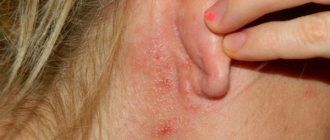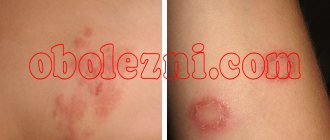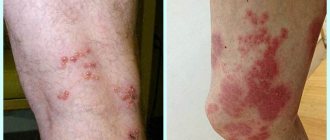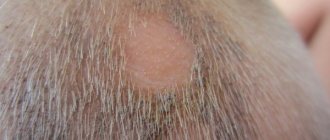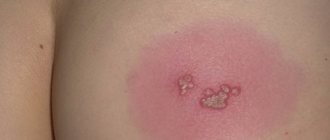How does it manifest itself?
Shingles often occurs in people who have previously had chickenpox. Both diseases have the same pathogen. After chickenpox, the herpes virus does not leave the body, but remains in a dormant stage. Under the influence of external negative factors, the immune system is weakened, and the pathogen manifests its activity. Once in the body, it spreads through the respiratory tract and tends to penetrate the lymph nodes, provoking the development of viremia.
The initial stage of shingles is similar in symptoms to regular flu: the patient feels severely unwell, his body temperature rises, body aches appear, etc. After a few days, red rashes appear on the skin, which begin to itch and burn severely. Over time, they burst, forming new localization sites, encircling large areas of the skin. Some patients are diagnosed with the internal form of herpes zoster. In this case, there is no external rash; the patient experiences neuralgic pain of varying intensity.
The appearance of rashes on the body is accompanied by a sharp increase in temperature; the next day after its appearance, it turns into small pimples filled with liquid contents inside.
The areas of the body most commonly affected by shingles are the abdomen, chest, and ribs. When pressing on the affected area, pain occurs. As the disease progresses, the rash blisters dry out and a thick crust forms on their surface. Relapses of the disease do not occur; having had this form of lichen once, a person develops immunity.
The blisters heal within 1 month with the use of specific medications. The nature of the manifestation of symptoms depends on the individual characteristics of the organism. In adults, the disease is more severe and the risk of complications is much higher.
How many days is shingles contagious?
No one doubts that herpes zoster is contagious. Moreover, the peak of its activity, and therefore the risk of infection, occurs from the first skin rash to the last. As soon as the rash stops, we can assume that the activity of the virus has subsided. During the period of drying and falling off of the crusts, the pathogen is no longer active and is not dangerous to others.
It turns out that the duration of the infectious period is 6-8 days.
Even if, after the crusts fall off, the patient experiences pain in the area that was affected, this only means that complications of a neuralgic nature remain. This does not pose any danger to others.
Causes of occurrence and routes of transmission
The main provoking factor is considered to be a severe weakening of the human immune system. Secondary reasons include:
- long-term use of a certain group of medications (corticosteroids, hormones, etc.);
- frequent stress and nervous tension;
- the presence of a malignant process in the body;
- HIV and AIDS.
People who have had chickenpox cannot become infected with the virus that causes shingles, and they develop immunity.
A person can become infected with this disease from a child suffering from chickenpox in the acute stage. Other routes of transmission include:
- transmission of the pathogen from mother to child during childbirth or in utero;
- by household means (using shared household items, cutlery, etc.);
- contact (by shaking hands, kissing or talking with a carrier of infection).
Anyone can become infected with the virus if the basic rules of personal hygiene and prevention of infectious diseases are not followed.
Development of pathology
photo of herpes zoster
Shingles is an uncontrollable infection secondary to chickenpox. According to the World Health Organization, the disease affects up to 100,000 people every year.
But it is important to note that the disease develops only in those people who have ever had chickenpox. People over 60 years of age most often get sick; this is due to a large number of factors in this age group that reduce immunity.
The answer to the question of whether shingles is contagious to others is definitely positive. The source of infection is an infected person or a patient in the active stage.
Incubation period
The incubation period of the herpes virus is between 13-17 days. Initially, the patient experiences the first symptoms, and after a few days a rash appears. In children, blisters and increased body temperature occur simultaneously. It is during this period of time that the patient is considered the most contagious; doctors recommend completely eliminating contact with healthy people.
The danger of the disease lies in the fact that the virus attacks the nerve endings. With out-of-date treatment, the patient experiences innervation of many nerves, and vision and hearing temporarily deteriorate. In severe cases, paralysis and postherpetic neuralgia occur. In this case, therapy is extended over a long period of time (at least 12 months).
Danger
Like chickenpox, shingles is very dangerous for others. In the initial stages of the disease, contact with family members is minimized and individual household items are used.
Is it possible to get infected from a sick person if you do not share the same utensils?
Most patients with herpes zoster have previously had latent or normal chickenpox. Often found in older people.
If a person has had chickenpox in the past, then their body develops immunity, so re-infection is excluded. The herpes virus is transmitted not only through household contact, but also through contact.
That is, you can become infected with lichen even using individual cutlery. The most dangerous is considered to be direct contact with the liquid from mature vesicles; it is in them that the infectious agent is concentrated.
Why is it dangerous for children?
Many children suffer from chickenpox in childhood; if poor treatment was carried out, the herpes virus goes into a latent form and, when the immune system is weakened, manifests itself in the form of herpes zoster. The danger of the disease in children lies in the possible addition of a bacterial infection. The blisters of the rash are very itchy, and in their place a wound forms, which is an excellent breeding ground for pathogenic microorganisms. In this case, the lichen develops into a severe form, and treatment measures are extended for several months. Usually, shingles with timely treatment in childhood occurs in a mild form.
ethnoscience
Ginger root tincture will help strengthen the immune system. It has a tonic effect on the body. You can add a piece of ginger to tea or coffee.
This will also have a positive effect on the immune system. Don't forget to do an allergy test before starting treatment with folk remedies.
The following remedies will help in the fight against the varicella-zoster virus:
- Raw buckthorn fruits. They should be taken on an empty stomach, 20 pieces each. The fruits strengthen the immune system, and the substances they contain help reduce skin itching.
- Treating rashes with a decoction of immortelle herb . It's difficult to prepare. It is necessary to pour a tablespoon of dry raw materials with a glass of boiling water. After the broth has cooled, you need to let it brew for 1-2 days, and then treat the affected areas of the skin with it. The plant will relieve itching and reduce pain.
How to avoid getting infected from a sick person?
In order to prevent herpes zoster in adult children, doctors recommend the following:
- Get unscheduled vaccinations.
- Avoid stress and nervous tension.
- Adhere to the rules of personal hygiene.
- Use personal hygiene products and cutlery.
- Limit contact with a sick person as much as possible. If I diagnose shingles in a child, then it is prohibited to take him to kindergartens and other educational institutions.
- Regularly strengthen your immune system.
- Include foods high in vitamins and microelements in your diet.
By following these simple rules, you can significantly reduce the risk of contracting the herpes zoster pathogen.
Shingles is very common and is a type of herpes infection. People who have previously had chickenpox and in whom the virus has become latent are susceptible to the disease. It is very important to recognize the first symptoms and begin treatment measures in a timely manner. During treatment, the patient is isolated from healthy people, since this type of lichen tends to be transmitted through contact and household contact.
Symptoms of herpes zoster
OH is characterized by a variety of symptoms that depend on the stage of pathogenesis. There are four main periods:
- Prodromal - from zero to the third, maximum tenth day;
- Acute – from the tenth to the twentieth day;
- Convalescence – from three weeks to three months;
- Long-term consequences – from three months to three years.
Symptoms of the prodromal stage consist of three components: general clinical, neurological disorders and skin rashes.
A combination of two of the four signs listed below is a reason to contact the clinic
- Febrile temperature is from 38 to 39°C, sometimes subfebrile from 37-37.5°C. The elevated temperature lasts no more than five to ten days. Prolonged hyperthermia is characteristic of herpes zoster complicated by meningitis or encephalitis. General symptoms are observed in approximately 20% of cases.
- Enlargement of regional lymph nodes, mainly on one side (on the neck, in the armpit, under the collarbone, in the groin) in areas of itching, pain and rashes.
- Pain in the areas of the rash (constant, paroxysmal, from touch, feels like burning, stabbing), which often persists for several months after recovery - “post-zoster neuralgia.”
- A blistering rash on one side of the body - on the chest, abdomen or face in the form of a band or spot surrounding the entire area. In 70% of patients, the rash appears within the first three days from the onset of fever.
Localization of rashes
The most typical locations for rashes in herpes zoster are the chest, head, neck and lower back. Approximate ratio of rashes on different parts of the body:
- Chest – 55%;
- Head – 23%;
- Neck – 12%;
- Lower back – 10%.
The rashes are localized in the area of dermatomes - areas of the skin innervated from the root of the nerve affected by the virus. Knowing the topography of the dermatomes (here) and the localization of the rash on the patient’s body, it is possible to determine which branch of the nerve is involved in the pathogenesis. The encircling projection of the pectoral dermatomas on the body explains the name of the disease.
Pathogenesis of rashes on the dermatome
Step-by-step pathogenesis of rashes on the dermatome:
- Erythema (redness);
- Papules – one to two days;
- Vesicles merging into groups of vesicles – five to seven days;
- Crusts are in place of the vesicles; the process is completed by the 30th day of the disease.
The erythema stage is very short or absent, the pathogenesis begins with papular rashes. If left untreated, the rash stage lasts about a month. A longer stage of rash (up to two to four months) is evidence of the patient’s immunodeficiency state. The intensity of the rash varies: from single to confluent forms of the rash. Sometimes a rash does not form at all. This form is called “zoster without rash” (zoster sine herpete).
Shingles is also found on the mucous membranes. Instead of a rash, shallow red erosions form.
In patients without a history of immunodeficiency, the rash is localized in one, rarely in several, dermatomes. It has been noted that a rash localized, for example, in the left dermatome, is rarely found in the similar right one, and vice versa. In immunodeficiency conditions of the patient, localization of the rash is found in the dermatome and throughout the body - this is a generalized form of herpes zoster. In case of HIV infection in a patient, the localization of the rash scattered throughout the body is called the disseminated form of herpes zoster.
Pain with herpes zoster
The pain may be:
- Only at the beginning of the disease;
- Throughout the illness (about a month);
- Long time after the symptoms of the disease disappear.
Post-zoster pain is a pain syndrome lasting more than four months (120 days) from the onset of the disease.
Characteristics of post-zoster pain
There are three types of unpleasant sensations described by patients with post-zoster pain syndrome:
- Constant, including burning, dull, deep, pressing;
- Spontaneous, including piercing, jerking, shooting;
- Provoked (occurring in up to 90% of all patients) – appears from touching the body, when dressing, or covering with a blanket.
In the acute period, pain does not necessarily correspond to the intensity of the rash. It almost always intensifies at night under the influence of external irritations, exposure to cold, heat or touch. Pain can also be caused by tight underwear. Phenomena of a paradoxical simultaneous combination of decreased and increased sensitivity of different parts of the body are often observed.
Herpes zoster is accompanied by inflammation of the nerve ganglion - ganglionitis. One or more nodes may be involved in pathogenesis. Nerve damage may be complicated by rapid loss of hearing or vision.
Options for the development of pathogenesis in individual nerve ganglia:
- Damage to the V pair of facial nerves and the trigeminal nerve. Localization of rashes - on the head, in the hairy or hairless zone, corresponding to one of the three branches of the nerve. Inflammation is accompanied by excruciating pain in the area of the rash, hyperthermia, and swelling of the subcutaneous tissue of the affected side of the head. A detailed examination reveals points of increased pain along the trigeminal nerve.
- Damage to the VII pair of facial nerves, its geniculate ganglion (Hunt syndrome). It manifests itself as rashes in the area of the ear canal, on the mucous membrane of the tongue and palate. Accompanied by dizziness, pain on the side of the head radiating to the face, neck or back of the head. It ends with complications in the form of paralysis of the facial muscles, unilateral hearing loss, and tinnitus.
- Damage to the cervical node. This node is formed by the branches of the four cervical spinal nerves C1-C4. The disease manifests itself as rashes in the neck and chest area. Accompanied by burning pain, sometimes pain on palpation on one side in the head, face and neck. It ends with disorders of skin sensitivity, prolonged pain in areas of the body innervated by the roots of the node.
- Damage to the cervicothoracic stellate ganglion. Causes pain in the chest area that resembles an angina attack. It ends with complications in the form of dysfunction of the innervated areas of the skin and internal organs. Changes in skin pigmentation, impaired sweating, and decreased tone are possible.
- Damage to the nerve nodes of the coccygeal zone. It manifests itself as rashes in the anus and severe pain. Possible complications: disturbance (delay) of urination, damage to the genital organs.
Ophthalmoherpes
Damage to the roots of the facial nerves innervating the eye area is called ophthalmoherpes. The disease manifests itself as keratitis, lesions of the sclera, iris and optic nerve in the form of its atrophy. Rashes, when the optic nerve roots are involved in the pathogenesis, are localized on one side of the head from eye level to the crown. In this case, the most dangerous are considered to be rashes on the wings and tip of the nose (Hutchinson's symptom). The combination of two herpes viruses: Varicella zoster virus and Herpes simplex is the most common cause of facial paralysis (Bell's palsy).
The presence of blistering rashes on the face is a reason to consult an ophthalmologist for advice and antiviral therapy, which reduces the likelihood of complications of herpes in the eyes by approximately 50%.
The diversity of pathogenesis underlies the clinical classification of herpes zoster.
Classification according to the localization of the pathogenesis of herpes zoster
The mandatory participation in the pathogenesis of symptoms of damage to the nervous system and skin rashes underlies the classification of herpes zoster.
Herpes zoster can manifest itself:
- Meningitis, encephalitis, meningoencephalitis (inflammation of the brain and its membranes, their combinations);
- Lesions of other organs of the nervous system (ganglionitis);
- Eye lesions (inflammation of the conjunctiva, eyelids, iris, eyeball and cornea);
- Rashes scattered (disseminated) throughout the body;
- Complications spreading to other organs and systems;
- Hidden flow without rashes;
- Atypical symptoms.
Diagnosis and differential diagnosis of herpes zoster
The definition and differentiation of the disease is carried out on the basis of a clinical interview, external examination and palpation of damaged areas.
The following similar pathologies are excluded:
- Lichen zosteriformis caused by herpes simplex;
- Contact dermatitis and insect bites;
- Bullous pemphigoid.
Laboratory methods – PCR diagnostics, identification of a specific virus. A sample is taken from the vesicle.

